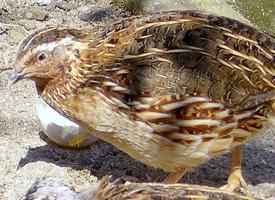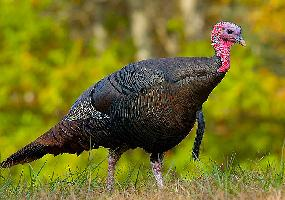
Állatleírás
The Common quail (Coturnix coturnix) is a small, elusive bird that belongs to the pheasant family, Phasianidae. It is widely distributed across Europe, Asia, and Africa, known for its distinctive "wet-my-lips" call that resonates through the fields in the breeding season. This species has adapted to a variety of habitats, ranging from agricultural lands to open grasslands and edges of forests, making it a versatile inhabitant of the Old World.Physically, the Common quail is a small, stout bird, measuring about 16 to 18 cm in length and weighing between 70 to 130 grams. It exhibits a rather cryptic plumage that serves as excellent camouflage against the ground and its surroundings. The bird's upper parts are a mottled brown, with darker and lighter markings that help it blend into the underbrush and avoid predation. Its underparts are paler, with a distinctive pattern of stripes and spots that varies from individual to individual. The face is marked with a white stripe above the eye and a darker stripe running through the eye, adding to its camouflaged appearance. Males and females are similar in size and coloration, though males may display slightly more vibrant hues during the breeding season.
One of the most remarkable features of the Common quail is its migratory behavior. Populations breeding in Europe and northern Asia undertake long migratory journeys to winter in Africa and southern Asia, showcasing remarkable endurance for such a small bird. During these migrations, they fly mostly at night, navigating vast distances with incredible precision.
The diet of the Common quail consists mainly of seeds, grains, and various invertebrates. This diet varies seasonally and with the availability of food resources in their habitat. During the breeding season, they may consume more invertebrates, providing them with the necessary protein for egg production and the growth of their young.
Breeding season for the Common quail typically begins in late spring and extends through the summer. The female lays a clutch of 7 to 14 eggs in a shallow nest on the ground, concealed among vegetation. These eggs are incubated for about 16 to 18 days before hatching. The chicks are precocial, meaning they are born well-developed with a full coat of down and are capable of following their mother and feeding themselves shortly after hatching. This rapid development is crucial for their survival, as it minimizes the time they are vulnerable to predators.
The Common quail's call is a distinctive and integral part of its breeding behavior. Males emit a series of repetitive, whistling sounds that serve to attract females and establish territories. These calls can be heard most frequently during the early morning and late evening hours throughout the breeding season.
Despite their wide distribution and abundance in certain areas, Common quail populations are subject to pressure from habitat loss, hunting, and agricultural practices. However, they are currently listed as Least Concern by the International Union for Conservation of Nature (IUCN), indicating that they are not at immediate risk of widespread decline.
In conclusion, the Common quail is a fascinating and resilient bird, adapted to a life on the move across continents. Its cryptic plumage, distinctive calls, and remarkable migratory journeys make it an intriguing subject of study for ornithologists and a beloved sighting for bird enthusiasts across its range.
Hasonló állatok
Új állatfotók
Top 10 állat
- Dolphin gull (Leucophaeus scoresbii)
- Diana monkey (Cercopithecus diana)
- Moustached guenon (Cercopithecus cephus)
- Galápagos tortoise (Geochelone nigra complex)
- Japanese macaque (Macaca fuscata)
- Greek tortoise (Testudo graeca)
- Stone loach (Barbatula barbatula)
- Russian tortoise (Testudo horsfieldii)
- Common flying dragon (Draco volans)
- Galápagos penguin (Spheniscus mendiculus)


